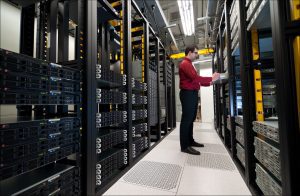Server technology continues to improve, packing more power in smaller packages. While that’s great for IT, it can create challenges for data centers that may be ill prepared to house such equipment.
High-density equipment such as blade servers, 1U servers, and multi-core high-end servers provide more computing per watt compared to previous generation servers. But they also consume more power and, consequently, throw off more heat. When a number of such servers are concentrated in a single rack, it may well overwhelm the existing data center cooling infrastructure.
As a result, a popular strategy has been to spread out high-density servers by installing fewer of them in each rack, thus dispersing them out throughout the data center. Following this strategy will likely enable the data center’s average power density to stay in the range it was originally designed for.
But the “spreading out” strategy may not be a viable option for a number of reasons:
- Consumption of additional floor space, which may be difficult to justify or simply not available
- Executive management perception that partially-filled racks are wasteful
- Increased cabling costs (because of longer runs)
- Increased cost and difficulty of maintenance – cabling and mounting may be intertwined with other equipment in a nonstandard manner, scattered throughout the room
- Reduced electrical efficiency of the data center, because cooling-system air paths are longer and less targeted. This results in increased mixing of hot and cool air, which decreases the efficiency of the air conditioning system.
A more effective solution for dealing with high-density equipment is to create high-density pods within the data center. That’s the focus of a free Schneider Electric Energy University course titled, “Deploying High-Density pods in a Low Density Data Center.”
In the course, a high-density pod is defined as one or more rows of racks that support a per-rack density average of 4 kW or above. The course details a number of options for how to build a high-density pod within the borders of a larger, low-density data center, each capable of giving the high-density equipment the cooling it requires.
The options basically come down to how exhaust heat is diverted back to air conditioners. The course discusses four possibilities and discusses the pros and cons of each:
- Uncontained
- Hot aisle containment
- Cold aisle containment
- Rack air containment
High-density pods are modular and independent of room-based cooling architectures and existing UPS architectures. That means few constraints exist to prevent their deployment in new or existing data centers. You need sufficient floor space with enough weight-bearing capacity but otherwise the course makes it clear that a standardized high-density pod can be installed in multiple types of data centers.
You will, however, have to make a decision on how to deploy a high-density pod: in-house or with vendor assistance. IT managers can easily deploy smaller sized pods or smaller data centers (less than 20 racks) with no previous experience, using a worksheet that comes with the course.
Projects involving data centers with 20 or more racks can get considerably more complex and the course recommends consulting with design experts and project managers for help. Such vendor-assisted deployments usually begin with an assessment of the existing data center or the design plans for a new data center. One such assessment is APC’s Data Center Power and Cooling Assessment.
The data uncovered in this assessment provides an estimate of cooling capacity and compares constraints against current and future requirements. Ultimately this will help answer the question, “When will I run out of cooling capacity and require a high-density pod?”
If your data center is seeing increased use of high-density equipment, a high-density pod may be in your future. To get ready, check out the free Schneider Electric Energy University course, “Deploying High-Density pods in a Low Density Data Center.” You’ll find it in the College of Data Centers at Energy University.



Conversation
Thank you for sharing this informative article about Learn How to Deploy High-Density Pods in a Low Density Data Center